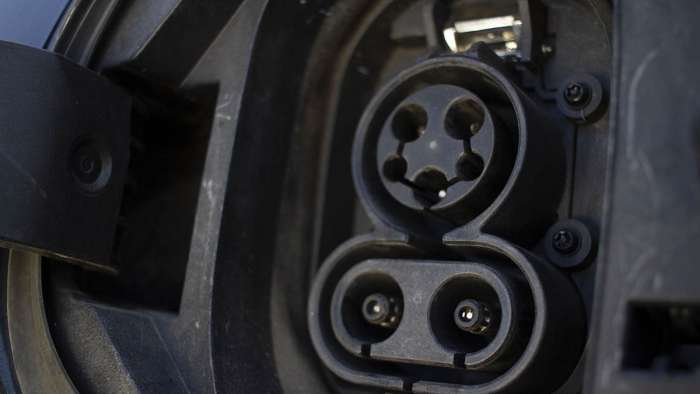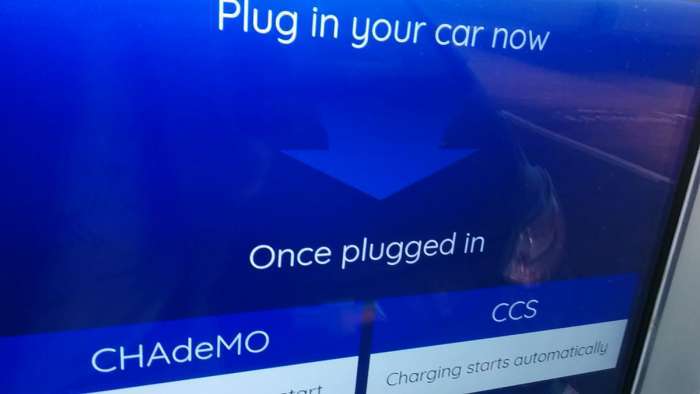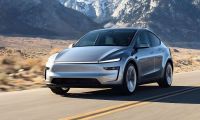For many Chevy Spark EV and Chevy Bolt EV owners, DC fast charging can be a mixed experience. There's already a learning curve for new electric vehicle owners who are coming from the world of fueling internal combustion vehicles; however, there are additional issues that owners of these two electric vehicles must be aware of in order to have positive, successful DC fast charging experiences. The CCS port on the Chevy Spark EV might need to be physically modified, and the Chevy Bolt EV requires owners to provide additional support when using heavier, liquid-cooled CCS cables. For future electric vehicle models, GM needs to reconfigure and redesign their CCS ports in order to assure the best customer experience.
In this story, I will explain some of the problems with the Spark EV and Bolt EV charging ports, the consequences and issues that result from these problems, the corrections and workarounds that are available to owners, and the ways in which GM should redesign their CCS ports moving forward.
Background
The Chevy Spark EV was one of the first CCS equipped electric vehicles built and sold in the United States. GM equipped the Spark EV with a power dense, 18.9 kWh battery pack capable of charging at over 50 kW (a 2.8 C charging rate, which is – amazingly – even faster than many modern Tesla models); however, GM didn't do a great job designing and finishing the Spark EV's CCS socket, which wasn't compatible with all the CCS plugs being manufactured. While GM corrected these CCS socket issues for both the later model Spark EV and the Bolt EV, they didn't fix all of the issues with their CCS ports, which include a finicky latch actuator and lock as well as a lack of support for heavier, liquid-cooled CCS cables.

These issues have led a number Spark EV and Bolt EV owners to blame charging providers for negative experiences when, in actuality, many of those negative experiences are likely the result of the car itself. Electrify America, in particular, has been subjected to the most criticism because they are using the heaviest, liquid-cooled cables and building charging sites in regions with little to no preexisting DC fast charging infrastructure (i.e., electric vehicle owners in those regions have less experience using public DC fast chargers).
In the following sections, I will review these CCS port issues in more detail, and I will describe existing solutions and workarounds.
Poor Latch Ramp Shape
Early Chevy Spark EVs were actually delivered with what could be considered faulty latch ramps. Most CCS plug designs have a sharp, angled latch ramp, but the early Spark EV's CCS port had rounded latch ramps, which prevented some CCS plugs from seating properly.
This issue is actually known by GM, and they released a service bulletin with instructions on how to correct it. A Spark EV owner outlined this process in a blog post. This is a modification that Spark EV owners can do themselves; however, I would advise caution before modifying your own charge port.
It appears that this early design issue didn't even last the full lifecycle of the Spark EV, and GM had definitely addressed it by the time they released the Chevy Bolt EV. That being said, while the Bolt EV has no issues with the public DC fast chargers that were built and deployed at the time of its release, the CCS standard has since increased in speed, requiring updated, liquid-cooled cables.
Lack of Cord Support
The new liquid-cooled CCS cables (which now support the fastest DC charging rates of any currently deployed standard) also have a cost. They are far heavier than cables that were available at the time of the Chevy Bolt EV's release. These new cables put far more downward stress on the Bolt EV's charging port, which negatively impact the latch actuator and connection pins.
When this connection is broken during the initialization, the charger fails to activate and typically kicks back an error that persists for a period of time. As a consequence, a number of frustrated Bolt EV owners have reported entire Electrify America sites as being down after attempting each charger one-by-one and getting an error each time.
There are several possible reasons why this is occurring, and the first is likely due to the coefficient of friction on latch ramps. Because these cables rely on a plastic-on-plastic seating position (and the latch ramps are a near 45 degree plane), the friction between two, smooth plastic surfaces might be too low to hold the heavier cords (causing slippage).

Another possibility is that the Bolt EV's latch ramps themselves might still be too large. Unlike the early Spark EVs, which had misshapen latch ramps, the Bolt EV's latch ramps are the proper shape. However, based on the feel of the socket when these heavier CCS cables are plugged in, it is possible that the Bolt EV's latch ramps are still too large. This makes fully seating the CCS plug harder, and the weight of the cord makes it sag, creating a separation from the communication pins and putting stress on the latch actuator. Personally, I don't think that it is worth it for owners to attempt to physically modify the Bolt EV's latch ramps; however, I do think that it is something GM should investigate as a possible correction.
The final possibility is that the Bolt EV's CCS port itself is simply angled in a way that does not allow it to support the weight of a heavier CCS cord. The result is, the extra weight of the liquid-cooled CCS cables literally pulls the plug out of the socket before the latch actuator has a chance to lock it into place.

Luckily, the remedy for this issue is very simple, though it is a bit inconvenient, especially for Bolt EV owners who are attempting to pay with a credit card or RFID. Essentially, you simply need to lift the CCS plug and cable vertically while the charge session initiates. Doing so alleviates pressure on the port and latch actuator, and it ensures proper contact with the communication pins as the charge session activates. Again, though, this requires you to use your hand, which means you might not be able to swipe a card and get back to the cord in time to lift and support it.
One of my viewers sent me another solution that uses a 3D printed plastic piece. The piece is simple and easy to construct, and it provides additional support at the base of the CCS cable, which enables you to plug in, walk to the charger, pay for the charge session, and not have to worry about rushing back to support the cable as the charge session initiates.

Possibly the best solution to this, however, is on the charging provider's side. Recargo has been delayed in their network build out, but they have created a system where their customers actually pay and activate the charger first, and then they have a short window to plug in the car. Because the charger is already activated and waiting for a signal from the car, it is simply a matter of lifting the CCS cord as you plug in, and the charging session will start. As plug-and-charge functionality is rolled out in the near future, this will probably be the most common solution for Bolt EV owners.
CCS Latch Required
One of the quirks of GM electric vehicles in regards to activating DC fast charging sessions is that they do require the CCS latch to be in place. As far as I understand it, this latch is required as part of the standard; however, several other automakers have clearly ignored that requirement. For example, the BMW i3 will allow a CCS plug to activate a charge even if the latch is broken or missing.
This is not, in my opinion, a fault on GM's side. Rather, this is an issue for the charging providers, CCS hardware providers, and SAE standards to address. In the case of the charging providers, they need to ensure that their equipment remains in good working order. This can be hard in an age of vandalism and abuse. I've seen charging cables strewn on the ground and in parking spaces. Some CCS plugs I've encountered have clearly been driven over,
Some of the abuse, however, does not necessarily look intentional. Many of the charging hardware providers appear to have initially designed their equipment for CHAdeMO cables, which do not have the same type of latching mechanism as CCS. Early chargers mount the CCS cables by having them plugged directly into the charger. If an EV owner is distracted or inattentive, they could try to lift the CCS plug out of its enclosure rather than pulling it out. Doing so can apply a massive amount of stress perpendicular to the latch, literally snapping the plastic latch in half.
Electrify America's latches appear to be of a much sturdier material than early CCS plug latches, and EVgo has started to use saddle type rests for their CCS plugs rather than a mount in the charger. Both of these can reduce the number of broken latches, but ultimately, these latches will eventually break through abuse or wear.
If some electric vehicles are able to activate and charge even in the case of a broken CCS latch, then all electric vehicles should be able to. Assuming this is safe, SAE should allow for some adjustments to their standard in these cases.
Unfortunately, though, there's not clear and clean solution for Chevy electric vehicle owners if they encounter a CCS charger with a broken latch. The best case scenario is that there are multiple, unoccupied CCS plugs or chargers at the site; however, it might be necessary to swap chargers with another EV owner who can use the charger. The worst case scenario is, of course, that you are unable to charge at all and must move onto another charging location.
Conclusion
Regardless of what, exactly, is preventing Chevy Spark EV and Chevy Bolt EV from activating public DC fast charging sessions, the CCS ports that GM is using on its electric vehicles need to be redesigned. Whether this is installing the CCS port at a slight angle to better support the weight of heavier charging cords or improving the sizing and tolerances of the charging port itself, GM needs to address this. In fact, GM should actually notify owners that they should be supporting heavier charging cables when initiating a new charging session, though they might be reluctant to acknowledge this issue if they feel it will open them to liability or recalls.
See you next time as I share how to lower the Chevy Bolt EV!
About The Author
Eric Way focuses on reporting expert opinion on GM brand electric vehicles at Torque News. Eric is also an instructional designer and technical writer with more than 15 years of writing experience. He also hosts the News Coulomb video blog, which focuses on electric vehicles, charging infrastructure, and renewable energy. Eric is an active member of the EV Advocates of Ventura County, a volunteer organization focused on increasing the widespread adoption of electric vehicles. You can follow Eric on News Coulomb Youtube, on Facebook at @NewsCoulomb as well as on Twitter at @eway1978.













Comments
I have a 2016 Spark EV. I
Permalink
I have a 2016 Spark EV. I have held and lifted the charge cord but it never works on the Electrify America ABB new chargers. It works on all other fast chargers. The best is the 62kW charge Point Fast Charger. E A won't help.
I used the silver poles that
Permalink
In reply to I have a 2016 Spark EV. I by Jim stack (not verified)
I used the silver poles that are protecting the charging station as leverage. That supported the liquid cooled cables and I got my spark to charge that way
Can you please give us a link
Permalink
Can you please give us a link to the 3d part design of the css cable support. I would be very interested in it. (I actually owns a 2016 chevy spark ev)
The way that I got it to work
Permalink
The way that I got it to work was using the piles that are protecting the charging station. I Attached the charging latch to the charging port on my spark and the liquid cooled cables on top of The Oilers that are protecting the charging station as leverage and the weight of the liquid cool cable was being supported by the poles and that got my spark to charge. The cables are heavy but those poles will help
I had to take my 2018 Bolt
Permalink
I had to take my 2018 Bolt into the dealer because it wasn't charging. They are telling me it has a bent pin and want to charge me $1.3k. I often use fast chargers. Seems like a design issue to me...but leave it to Chevy to make it a customer issue and not an engineering/design issue. Sigh.
Separate from the latch issue
Permalink
Separate from the latch issue, the CCS port connection break during handshaking or initialization with liquid-cooled cables is not limited to GM vehicles. Our CCS Honda does the same thing, but only with chargers from certain vendors. This leads me to suspect that one cause might be parts from a third party supplier. ChargePoint is now installing chargers with liquid cooled cables; I have used them with CHAdeMO but not CCS yet - it will be interesting to see how solid the connection is. In any event, I object to having to hold up a charging cable with one hand while "swiping" a bar on an app to start a charge with the other. Ridiculous!
I was considering a SparkEV
Permalink
I was considering a SparkEV as a cheap intro to electric vehicles, (the reason this article showed up in Google for me). And yet another reason now exists to slow EV adoption. I'm getting too old for early adopter crap. I'll just stick with tried and true petrol vehicles until EVs are better implemented.
I have a leased 2019 Chevy
Permalink
I have a leased 2019 Chevy BOLT EV. I have been charging it at my home for the last year and a half. Lately, I smelled rubber burning type smell in the morning after charging in my garage. In fact last night the charging stopped in the middle of night and it short circuited the power and my whole house power was cut off. The garbage was filled with the "burning rubber smell". I had to turn on the tripped lever to bring the power to the house. Does anybody have such an experience with the charging of BOLT EV. I do not know whether it is Car issue or the charger issue. I found that the charger is OK. Please tell about such an experience if you have had in the past or are experiencing.
Charge your car somewhere
Permalink
In reply to I have a leased 2019 Chevy by Raj (not verified)
Charge your car somewhere else until an electrician can inspect your wiring. This should not happen. In 6 years of home charging, our outdoor breaker (GFCI) has tripped 3 times with 2 different cars. We just pressed the reset button on the breaker. Shop could find nothing wrong with cars.